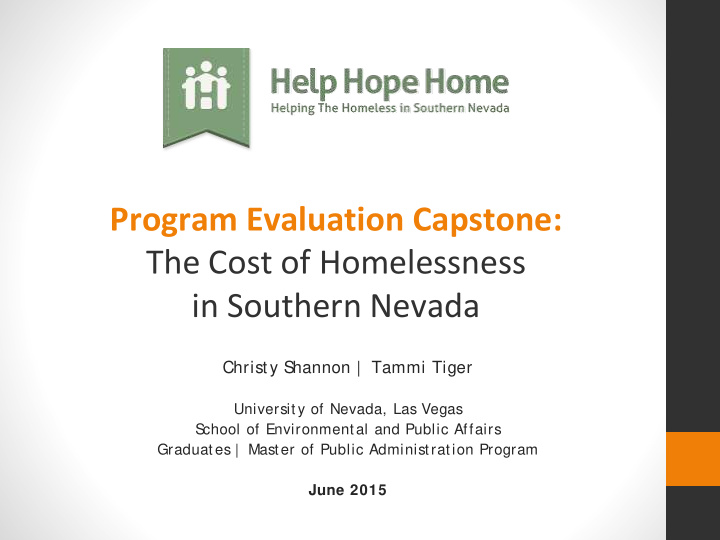



Program Evaluation Capstone: The Cost of Homelessness in Southern Nevada Christy S hannon | Tammi Tiger University of Nevada, Las Vegas S chool of Environmental and Public Affairs Graduates | Master of Public Administration Program June 2015
Agencies Interviewed • Catholic Charities • Salvation Army • HELP of Southern Nevada • Shannon West Homeless Youth Center • Nevada Partnership for Homeless Youth • Nevada HAND • Women’s Development Center • Safe Nest Temporary Assistance for Domestic Crisis • The Shade Tree • Family Promise • Lutheran Social Services • U.S. Vets 2 • Clark County School District Title I HOPE
Sources • 2014 Southern Nevada Homeless Census data • Existing research on homelessness • National and local information, most current • Housing First models implemented in the U.S. • Community/nonprofit agencies that work with homeless populations • Contacts provided by SNRPC • Public agencies/data 3 • Bitfocus Homeless Management Information System (HMIS)
Limitations: Barriers to Data Acquisition • Varying methods in agency data tracking • Different degrees of data sophistication and staff structures from one agency to another • Agencies often operate on different budget cycles • Grant funding requires specific data measurements • Homeless data tracking requirements for some Clark County/public agencies were not implemented until recently • HMIS is primarily concerned with services and has limited cost data 4 • Veterans Affairs does not currently enter service data into HMIS
Chronic Homeless by the Numbers • 760 Individuals on any given night in Southern Nevada • Of these, 95% are unsheltered (724) • 9.4% increase from 2013 (695) • Consume 75% of public resources due to substance abuse, physical and mental health barriers • Represent only 8% of total point-in-time homeless population • Based on our study, the long-term cost of managing 5 homelessness on the streets is 3 times greater than the cost of permanent supportive housing.
Summary of Public Costs PUBLIC SERVICE AVG COST ($) COST UNIT Short-term Treatment: $318 Per Admission Triage/Mental Health Crisis and/or (Avg 3 days, $53/day) Stabilization/ Detox Inpatient Treatment: $8,125 Per Admission Substance Abuse/Rehabilitation (Avg 65 days, $125/day) Ambulance to Hospital $936 Per Transport UMC Emergency Room Visit $1,998 Per Visit Jail $1,530 Per Stay (10 day avg, $153/day) Meals $4,179 2 meals per day for one year Emergency Shelter—Nights $7,311 $20.03 per night for one year Inclement Weather Shelter —Winter $1,588 1 Person per Season (133 days/ $11.94 daily) Inclement Weather Shelter —Summer $2,563 1 Person per Season 6 (153 days/$16.75 daily) Public Clean-up: $1,500 County labor & equipment costs to Property/streets/tunnels remove 1 encampment
Public Costs: Medical • University Medical Center (Primary provider of health care for indigent/homeless patients) • $1327 to $3895/day, depending on unit/care level • The most frequent users average $1998/ER visit • WestCare • Short-term–Detox: Average stay is 3 days at $53/day • Long-term–Rehabilitation: Average stay is 65 days at $125/day • Clark County Business License Office – Maximum allowable ambulance service rates for 2014-2015: • $936 average/ride 7 • Range of rates by service category: $799.74 - $1,116.21
Public Costs: Incarceration • Clark County Detention Center and City of Las Vegas Jail • $135/day and $170/day, respectively – average incarceration cost of $153/day • From 2013 -2014, each facility averaged 2,934 homeless inmates per year • Estimated average stay for homeless inmates: 10 days • Most are charged with misdemeanors • Cost of $3.62 million in 2013; $4.38 million in 2014 8
Public Costs: Clean-up Maintenance of flood control channels and public right-of-way $1,500 for one-time clean-up 9
Case Study: One Year Chronically Homeless UNSHELTERED: 2 meals per day; use of inclement weather day shelters for 100 days (50 each season); 10 months on the street incurring monthly clean-up of the encampment; 2 months in the following: emergency shelter, 2 ER visits via ambulance, 2 short-term detox and incarceration (average visits). SHELTERED: 2 meals per day; use of inclement weather day shelters for 100 days; nightly use of emergency shelter; one ER visit via ambulance; one instance of detox and incarceration. PERMANENT SUPPORTIVE: * 65 days in a stabilization detox program before entering a permanent supportive housing program for chronically homeless such as Horizon Crest 10 (**long-term cost).
Case Study: Cost Comparison Example Incarceration $30,000 Detox $25,000 ER Medical $20,000 Ambulance $15,000 Rehabilitation $10,000 278 383 Weather Day Shelter Beds Beds $5,000 Meals $0 Shelter or Housing 11 County Clean-up
Recommendations Continue to integrate public agencies involved with the homeless solution into HMIS to complete the cost picture Conduct long-term case studies (1-2 years) of homeless individuals who utilize HUD’s Continuum of Care programs to gather more representative data Once data has been collected and analyzed, focus on resources that have been proven most effective – especially regarding supportive housing programs 12
Recommend
More recommend